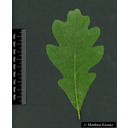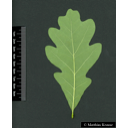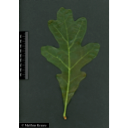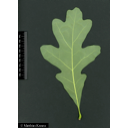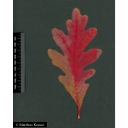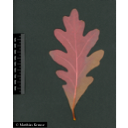Useful information about the taxon (species, subspecies, variety...)
Quercus alba L. 1753
Fagaceae
(APG IV)white oak, stave oak, fork-leaf oak
Akzessionnummer: LG-T-035-17822
Pflanzjahr: 1998
Patenschaftstext: Für Corinna, Joachim + Annika 2001
Taxon concept: The Plant List (2014), version 1.1
Distribution: eastern Canada, eastern United States incl. Florida
Quercus alba L. - Accepted: Quercus alba L. bei The Plant List (2014), version 1.1; Familie: Fagaceae (APG III)
- Color of flower
- male (staminate) flowers yellowish, female (pistillate) flowers reddish
- Flowers
- monoecious; flowers in catkins
- Flower ecology
- wind-pollinated (anemophilous)
- Life form
- tree
- Leaves
- violet-purple foliage in autumn
- Foliage persistence
- deciduous
- Fruits
- short-stalked, glabrous acorns with warty cupule
- Fruit ecology
- zoochorous (by blue jays, grey squirrels and formerly by pigeons), anemochorous and barochorous
- Soil conditions
- common on rocky soils
- Root type
- taproot
- Natural occurrence (habitat)
- rich uplands, moist bottomlands, along streams, hammocks, sinks, sandy plains, gravelly slopes, coves, pine-oak-hickory woods, beech-maple forests, mixed deciduous forests, oak savannas (with post oak and bur oak)
- Vegetation typ and synecology (plant community)
- temperate, mesophytic broad-leaved deciduous and mixed forests and temperate grasslands, savannas, and shrublands
- Constraints according radiation (light)
- not shade tolerant
- Constraints according habitat
- moderately resistant to fire
- Life span
- long-lived tree (up to 600 years)
- Usage
- as ornamental tree; wood is currently used for furniture, veneer, staves of barrels (especially for whiskey barrels), flooring, paneling and interior woodwork; oils obtained from pressed acorns were used to alleviate joint pain; wood was used for railroad ties, fence posts, mine timbers, ships, and caskets; due to high fuel value very suitable as firewood
- Bark
- light grey bark
Erhardt, W., Götz, E., Bödeker, N. & Seybold, S. (2008): Der große Zander. Enzyklopädie der Pflanzennamen. Band 2. Arten und Sorten. Eugen Ulmer KG, Stuttgart (Hohenheim), 18. Aufl., 2103 S.; Global Biodiversity Information Facilty (GBIF). Online Publication: www.gbif.org; The International Plant Names Index (2009). Published on the Internet http://www.ipni.org; Courtesy to IPNI, 2009. Exported from IPNI at date: 2009-09-22 20:17:51;
Diese Webseite verwendet Google Maps, um Karten und Standorte von Pflanzen in den Hohenheimer Gärten anzuzeigen. Dadurch werden unter Umständen Daten an Google weitergeleitet, was mit einer Verarbeitung Ihrer personenbezogenen Daten verbunden sein kann. Die Datenschutzerklärung von Google finden Sie hier: Datenschutzerklärung von Google

